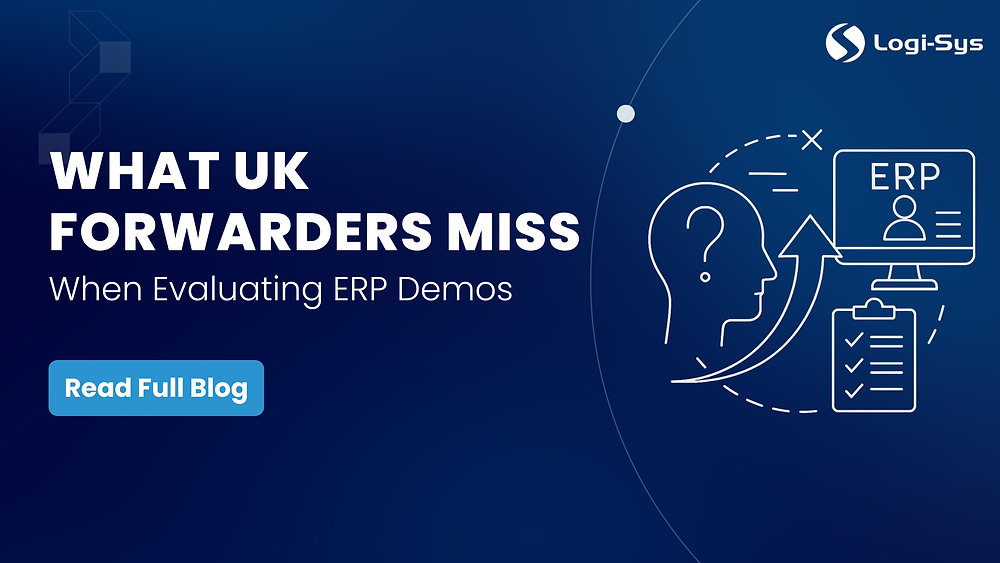
The Real Gaps Don’t Appear in Demos—They Appear in Deployment
Software demos are carefully designed. They show what works well: job creation, document printing, and how a user navigates the screen. But for freight forwarders in the UK, that’s only a fraction of what actually matters.
The reality of day-to-day operations—managing cost flows, tracking jobs across branches, delivering VAT-ready billing, aligning sales to operations, ensuring nothing is missed—is rarely reflected in a 30-minute walkthrough.
Yet those are precisely the areas where the right freight management system can create scale, efficiency, and control. And where the wrong one adds manual effort, misalignment, and downstream risk.
What UK Forwarders Should Look for in Freight ERP
1. Financial and Operational Linkage
The system should tie every job to its financial lifecycle: costing, invoicing, collections, and margin tracking—without requiring external accounting software.
2. VAT-Ready Processes
VAT compliance shouldn’t live in spreadsheets. Look for built-in VAT handling, audit trails, invoice configuration, and period locking tailored for UK finance teams.
3. Multi-Branch, Multi-Currency Structure
If your business operates across multiple depots or offices, your ERP should support inter-branch billing, branch-wise P&L, and shared vendor/customer accounts with full visibility.
4. Workflow Automation with Task-Level Ownership
A system should assign tasks, enforce SLAs, automate approvals, and escalate delays. Real-world freight doesn’t run on email reminders.
5. Shipment Execution Across All Modes
Support for air, sea, and road freight—including direct, consolidated, and back-to-back jobs—should be standard, not optional.
6. CRM That Connects to Jobs and Margins
From lead to quote to job to invoice. The CRM should be tied to actual performance—not floating separately from operations.
7. Portals for Customers and Vendors
Visibility shouldn’t depend on manual updates. The system should offer self-service access for shipment tracking, document retrieval, billing status, and collaboration.
8. Mobile Access and Remote Control
Teams in freight don’t sit at desks all day. Mobile functionality for approvals, updates, alerts, and finance actions is essential for responsiveness.
9. Alerts, Approvals, and Compliance Controls
Financial and operational security must be enforced through locks, custom rules, and audit trails—not dependent on discipline alone.
10. Business Intelligence Across Roles
Management needs real-time insights. The system should provide dashboards for job profitability, aging reports, salesperson performance, and branch-level KPIs.
These are not feature requests—they are structural requirements for any freight forwarding software designed to support modern UK operations.
How Logi-Sys Delivers—Across the Full Freight Lifecycle
Here’s how it answers every requirement listed above—natively, without patchwork.
Unified Operations and Finance
From the moment a job is created, Logi-Sys ties it to cost codes, revenue estimates, and billing rules. Each operational milestone triggers financial events—whether it’s generating an invoice or tracking receivables. No rekeying, no handoffs.
UK-Ready VAT Management
Logi-Sys supports VAT-compliant invoicing, with configurable tax structures, audit-friendly reporting, and built-in financial locks. Period closures prevent backdated changes, while credit control and tax-ready ledgers reduce audit exposure.
Multi-Branch Scalability
Offices can operate independently with their own teams, jobs, and billing—yet still report into a centralized dashboard. Inter-office reconciliation, branch-level profitability, and group-wide control come built in.
Air, Sea, and Road Freight Execution
Manage direct, consolidated, and back-to-back shipments across all transport modes. With integrated documentation (AWB, BL, HBL, manifests) and automated milestone updates, shipments are tracked and accounted for throughout.
Sales and CRM Integration
Leads convert into quotes. Quotes convert into jobs. Jobs feed invoicing and margin analysis. Sales teams track conversion performance, campaign ROI, and customer lifetime value—all within the same system as operations and finance.
Automated Workflows and SLA Enforcement
Roles and responsibilities are assigned at the task level. Delays trigger automated alerts. Approvals follow pre-defined flows. Whether it’s a pending customs document or a finance hold, the system keeps the process moving—and visible.
Customer and Vendor Portals
Clients can log in to track their shipments, download documents, and view invoices. Vendors can upload bills and check payment status. These portals reduce manual dependencies and improve service responsiveness.
Mobile Control and Approvals
Team members can approve quotations, payments, and shipments from anywhere. Mobile notifications alert users to pending tasks, delayed actions, or exceptions requiring intervention.
Compliance Through Control
Logi-Sys enables three levels of locking—operational, financial, and period-based. This prevents late-stage data changes and enforces reporting integrity, especially valuable for VAT accuracy and customer audits.
Real-Time Dashboards and BI
Executives can view profit per job, branch-wise revenue, aging receivables, unbilled jobs, and salesperson performance. With live dashboards, decisions don’t rely on outdated spreadsheets.
Why Fit Matters More Than Features
ERP selection isn’t about ticking boxes. It’s about choosing a freight management system that reflects how your business actually operates—across people, processes, and priorities.
Logi-Sys offers more than just features. It offers infrastructure that supports every stakeholder in your business: the ops team managing bookings, the finance lead handling collections, the sales rep quoting to win, and the branch manager accountable for performance.
That’s what UK freight buyers deserve to see—not just in a demo, but in real use.
